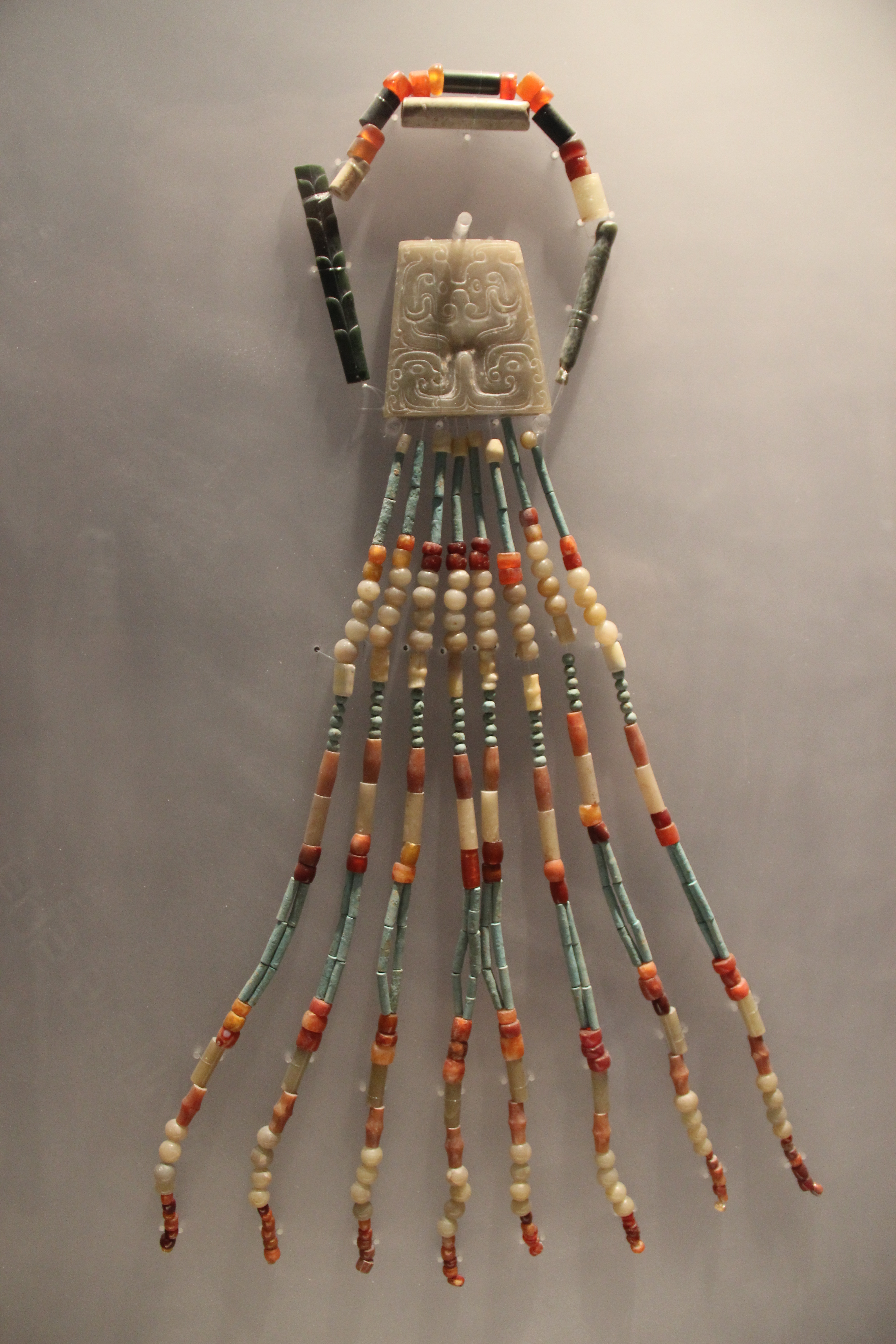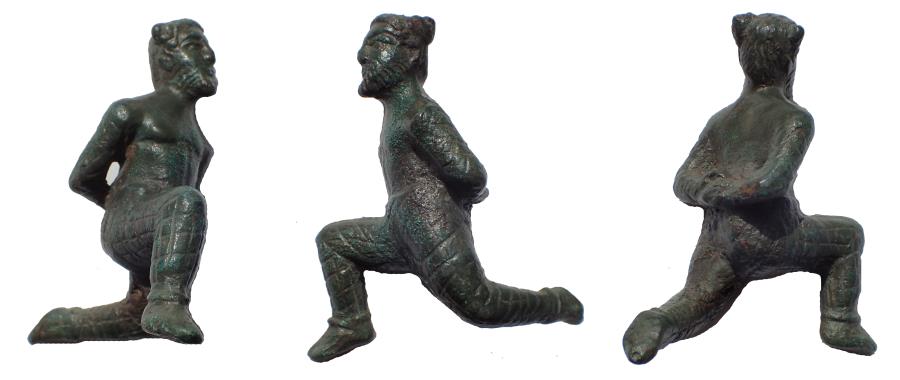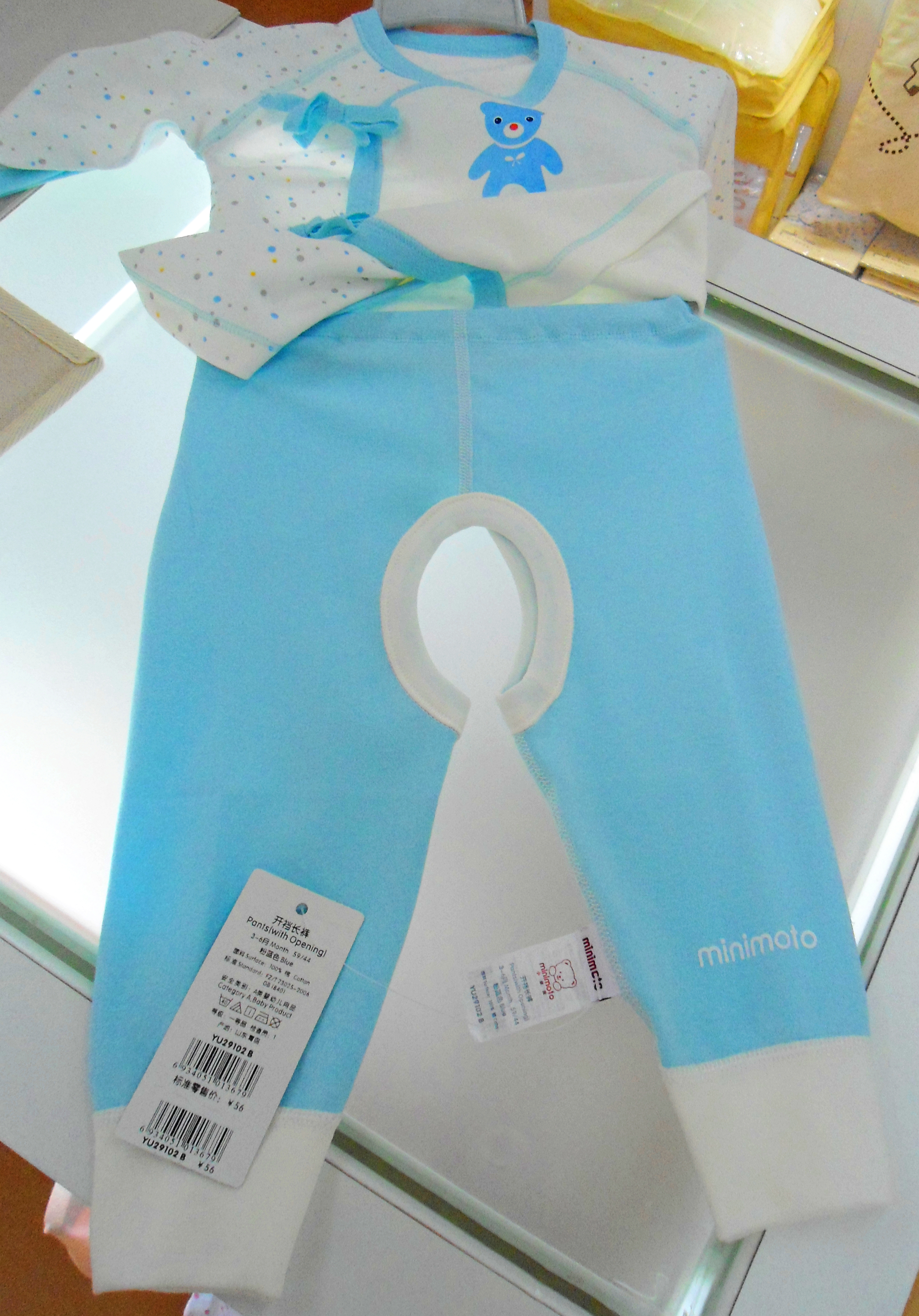|
Bianfu
() is a historical set of attire in consisting of a knee-length Chinese upper garment known as () over a , a Chinese skirt, known as () or pair of -trousersalong with other accessories. Coupled with the Chinese headwear known as ', the complete set of attire is also referred as (). This set of attire was considered to be a ceremonial dress. In the Zhou dynasty, the was only ranked-second after the and it was worn by the emperors when he would work on official business or when he would meet with the court officials. Construction and design The upper garment known as () which was red in colour and extended all the way to the knees. This was typically worn over a red skirt known as () that reached the length of the ankles. The wearing of a under an upper garment was only worn during formal occasions. Over the , the wearer wore a red coloured . Under the red outer garments, an inner garment known as () was worn. A () would be held in its wearer's hands; it was further a ... [...More Info...] [...Related Items...] OR: [Wikipedia] [Google] [Baidu] |
List Of Han Chinese Clothing
''Hanfu'' are the historical clothing of the Han Chinese, here categorized by clothing style. Informal wear Types include tops and bottoms, long skirt, and one-piece robes that wrap around the body once or several times (shenyi). ''Zhongyi'' (中衣), which is usually the inner garment much like a Western T-shirt and pants, can be wear along in casual. The typical set of informal wear consists of two or three layers. The first layer is mostly ''zhongyi'' (中衣). The next layer is the main layer which is mostly closed at the front. There can be an optional third layer which is often an overcoat called a ''zhaoshan'' which is open at the front. For footwear, white socks and black cloth shoes (with white soles) are the norm. But in the past, shoes may have a front face panel attached to the tip of the shoes. Semi-formal wear Generally, this form of wear is suitable for meeting guests or going to meetings and other special cultural days. This form of dress is often worn by ... [...More Info...] [...Related Items...] OR: [Wikipedia] [Google] [Baidu] |
Mianfu
Mianfu () is a kind of Chinese clothing in hanfu; it was worn by emperors, kings, and princes, and in some instances by the nobles in historical China from the Shang to the Ming dynasty. The mianfu is the highest level of formal dress worn by Chinese monarchs and the ruling families in special ceremonial events such as coronation, morning audience, ancestral rites, worship, new year's audience and other ceremonial activities. There were various forms of mianfu, and the mianfu also had its own system of attire called the mianfu system which was developed back in the Western Zhou dynasty. The mianfu was used by every dynasty from Zhou dynasty onward until the collapse of the Ming dynasty. The Twelve Ornaments were used on the traditional imperial robes in China, including on the mianfu. These Twelve Ornaments were later adopted in clothing of other ethnic groups; for examples, the Khitan and the Jurchen rulers adopted the Twelve ornaments in 946 AD and in 1140 AD respectively. ... [...More Info...] [...Related Items...] OR: [Wikipedia] [Google] [Baidu] |
Han Chinese Clothing
''Hanfu'' (, lit. "Han Chinese, Han clothing"), also known as ''Hanzhuang'' (), are the traditional styles of clothing worn by the Han Chinese since the 2nd millennium BCE. There are several representative styles of ''hanfu'', such as the (an upper-body garment with a long outer skirt), the (an upper-body garment with a long underskirt), the and the , and the (an upper-body garment with Ku (trousers), ku trousers). Traditionally, ''hanfu'' consists of a Paofu, ''paofu'' robe, or a Ru (upper garment), ''ru'' jacket worn as the upper garment with a Qun, ''qun'' skirt commonly worn as the lower garment. In addition to clothing, hanfu also includes several forms of accessories, such as List of Hanfu headwear, headwear, Hanfu footwear, footwear, Hanfu accessories#Waist Ornaments, belts, Hanfu accessories#Jewellery, jewellery, and Hand fan, handheld fans. Nowadays, the hanfu is gaining recognition as the traditional clothing of the Han ethnic group, and has experienced a growing ... [...More Info...] [...Related Items...] OR: [Wikipedia] [Google] [Baidu] |
Gujin Tushu Jicheng
The ''Complete Classics Collection of Ancient China'' (or the ''Gujin Tushu Jicheng'') is a vast encyclopedic work written in China during the reigns of the Qing dynasty emperors Kangxi and Yongzheng. It was begun in 1700 and completed in 1725. The work was headed and compiled mainly by scholar Chen Menglei (). Later on the Chinese painter Jiang Tingxi helped work on it as well. The encyclopaedia contained 10,000 volumes. Sixty-four imprints were made of the first edition, known as the Wu-ying Hall edition. The encyclopaedia consisted of 6 series, 32 divisions, and 6,117 sections. It contained 800,000 pages and over 100 million Chinese characters, making it the largest leishu ever printed. Topics covered included natural phenomena, geography, history, literature and government. The work was printed in 1726 using copper movable type printing. It spanned around 10 thousand rolls (). To illustrate the huge size of the ''Complete Classics Collection of Ancient China'', it is est ... [...More Info...] [...Related Items...] OR: [Wikipedia] [Google] [Baidu] |
Yupei
Yupei () is a generic term for jade pendants. Yupei were popular even before Confucius was born. Jade culture is an important component of Chinese culture, reflecting both the material and spiritual culture. Jade is deeply ingrained in Chinese culture and played a role in every aspect of social life; it is also associated with positive qualities and aspects such as purity, excellence, and harmony.Jade is even more valued than gold in Chinese culture. The history of the art of jade carving in China to make ornaments, including dress ornaments, extends back to before 5000 BC. Ancient Chinese held even greater importance to ''yupei'' after it was regarded as a moral integrity by Confucius. Yupei could be used as belt or waist ornaments (such as ''jinbu'' 禁步) and as necklaces which appeared as early as the Liangzhu culture. Strings of jade pendant are also used to decorate headwear, such as the Benkan, mianguan. Terminology Yupei () is composed of the Chinese character ''yu'' () ... [...More Info...] [...Related Items...] OR: [Wikipedia] [Google] [Baidu] |
Jade
Jade is an umbrella term for two different types of decorative rocks used for jewelry or Ornament (art), ornaments. Jade is often referred to by either of two different silicate mineral names: nephrite (a silicate of calcium and magnesium in the amphibole group of minerals), or jadeite (a silicate of sodium and aluminum in the pyroxene group of minerals). Nephrite is typically green, although may be yellow, white or black. Jadeite varies from white or near-colorless, through various shades of green (including an emerald green, termed 'imperial'), to Lavender (color), lavender, yellow, orange, brown and black. Rarely it may be blue. Both of these names refer to their use as gemstones, and each has a mineralogically more specific name. Both the amphibole jade (nephrite) and pyroxene jade are mineral aggregates (rocks) rather than mineral species. Nephrite was deprecated by the International Mineralogical Association as a mineral species name in 1978 (replaced by tremolite). The ... [...More Info...] [...Related Items...] OR: [Wikipedia] [Google] [Baidu] |
Bixi (clothing)
(; ), also known as (), is generic term which refers to a type of traditional Chinese decorative piece of fabric, which acts as a knee covering, in . The originated in China where it originated from the primitive clothing of the ancient; since then, it continued to be worn by both men and women, and eventually became part of the Chinese ceremonial attire. The was later introduced in Korea during Goryeo and Joseon by the Ming dynasty, along with many garments for royalties. History The originated from primitive clothing back when animal hides were used to cover the abdomen and the genitals. During the Shang dynasty, the basic style of clothing for men and women consisted of and . Among many other types of female clothing items, the was listed in tomb inventories dating from 361 AD. In the Ming dynasty, the became part of the official clothing. Construction and design The is a length of fabric which is typically long enough to reach the kneel-level and cover the ... [...More Info...] [...Related Items...] OR: [Wikipedia] [Google] [Baidu] |
Guan (headwear)
Guan (), literally translated as hat or cap or crown in English, is a general term which refers to a type of Headgear, headwear in Hanfu which covers a small area of the upper part of the head instead of the entire head. The was typically a formal form of headwear which was worn together with its corresponding court dress attire. There were Sumptuary law, sumptuary laws which regulated the wearing of ; however, these laws were not fixed; and thus, they would differ from dynasty to dynasty. There were various forms and types of . Cultural significance and symbolism In ancient China, there were various forms of headwear, which included (), (), (), (), and (). The code of wearing forms a crucial aspect of the Hanfu system. According to philosopher Wang Chong in ''Lunheng''; In ancient China, Han Chinese men had to undergo a capping ceremony called as their coming of age ceremony where a guan was placed on their head by a respected elder. The started by the nobles of the ... [...More Info...] [...Related Items...] OR: [Wikipedia] [Google] [Baidu] |
Hanfu
''Hanfu'' (, lit. "Han Chinese, Han clothing"), also known as ''Hanzhuang'' (), are the traditional styles of clothing worn by the Han Chinese since the 2nd millennium BCE. There are several representative styles of ''hanfu'', such as the (an upper-body garment with a long outer skirt), the (an upper-body garment with a long underskirt), the and the , and the (an upper-body garment with Ku (trousers), ku trousers). Traditionally, ''hanfu'' consists of a Paofu, ''paofu'' robe, or a Ru (upper garment), ''ru'' jacket worn as the upper garment with a Qun, ''qun'' skirt commonly worn as the lower garment. In addition to clothing, hanfu also includes several forms of accessories, such as List of Hanfu headwear, headwear, Hanfu footwear, footwear, Hanfu accessories#Waist Ornaments, belts, Hanfu accessories#Jewellery, jewellery, and Hand fan, handheld fans. Nowadays, the hanfu is gaining recognition as the traditional clothing of the Han ethnic group, and has experienced a growing ... [...More Info...] [...Related Items...] OR: [Wikipedia] [Google] [Baidu] |
Trousers
Trousers (British English), slacks, or pants ( American, Canadian and Australian English) are an item of clothing worn from the waist to anywhere between the knees and the ankles, covering both legs separately (rather than with cloth extending across both legs as in robes, skirts, dresses and kilts). Shorts are similar to trousers, but with legs that come down only as far as the knee, but may be considerably shorter depending on the style of the garment. To distinguish them from shorts, trousers may be called "long trousers" in certain contexts such as school uniform, where tailored shorts may be called "short trousers" in the UK. The oldest known trousers, dating to the period between the thirteenth and the tenth centuries BC, were found at the Yanghai cemetery in Turpan, Xinjiang ( Tocharia), in present-day western China.Smith, Kiona N.,The world's oldest pants are a 3,000-year-old engineering marvel, ''Ars Technica'', 4 April 2022. Made of wool, the trousers had strai ... [...More Info...] [...Related Items...] OR: [Wikipedia] [Google] [Baidu] |
Ku (trousers)
Ku () or (), collectively refers to the traditional Chinese trousers in in the broad sense. can also refer to the (), which are Chinese trousers without a rise as opposed to the trousers with a rise, referred as () or () in ancient times. The upper garment , the which evolved from the which existed since the Neolithic period, and the () from which the () eventually evolved from, are indigenous to Central area of China. When the is combined with the upper garment and the , the complete attire in the -system is formed. The is worn as a lower garment in a set of attire known as and/or sometimes be worn under the skirt of the . With time, the Chinese trousers evolved and changed in a variety of shapes and styles. The adoption of the used in the of Northern nomadic people through the adoption of the policy by King Wuling of Zhao during the Warring States period eventually made the -style trousers popular among the ancestors of the Han Chinese and the Ethnic minorities ... [...More Info...] [...Related Items...] OR: [Wikipedia] [Google] [Baidu] |








